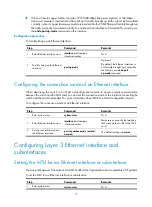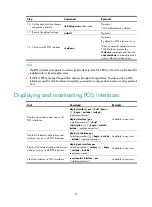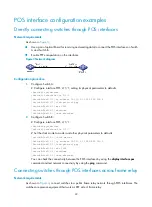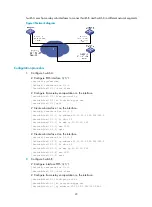
8
Step Command
Remarks
4.
Set the duplex mode.
duplex
{
auto
|
full
|
half
}
Optional.
The default setting is
auto
.
A fiber port does not support
half
keyword.
10-GE interfaces do not support
this command.
5.
Set the transmission rate.
speed
{
10
|
100
|
1000
|
auto
}
Optional.
The default setting is
auto
.
6.
Restore the default settings.
default
Optional.
7.
Set the intended bandwidth.
bandwidth
bandwidth-value
Optional.
Configuring an Ethernet subinterface
Step Command
Remarks
1.
Enter system view.
system-view
N/A
2.
Enter Ethernet interface view.
interface
interface-type
interface-number
N/A
3.
Configure the interface to
operate in Layer 3 mode.
port link-mode route
By default, an Ethernet interface
operates in Layer 2 mode.
4.
Return to system view.
quit
N/A
5.
Create an Ethernet
subinterface.
interface
interface-type
interface-number.subnumber
This command also leads you to
Ethernet subinterface view.
6.
Set the interface description.
description
text
Optional.
By default, the description of an
interface is in the format of
interface-name
Interface
. For
example,
GigabitEthernet3/0/2.1
Interface
.
7.
Restore the default settings.
default
Optional.
NOTE:
For the local and remote Ethernet subinterfaces to transmit traffic correctly, configure them with the same
subinterface number and VLAN ID.
You can configure IP-related settings on an Ethernet subinterface. For more information, see
Layer 3
—
IP
Services Configuration Guide
.
Bringing up Ethernet interfaces and subinterfaces
You can use the commands in this section to bring up a single Ethernet interface in Ethernet interface view,
or to bring up multiple Ethernet interfaces in port group view.
To bring up Ethernet interfaces:
















































